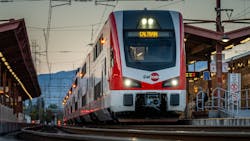California to have fully connected zero-emission rail network by 2050
California Gov. Gavin Newsom has released the State Rail Plan, a long-range vision of statewide investments that will create up to 900,000 jobs and a zero-emission, fully interconnected rail and transit network by 2050. The release of the plan comes after Newsom joined local leaders and workers Jan. 6 to mark the beginning of the track-laying phase for California high-speed rail, which will serve as the backbone of the state’s rail network.
The plan calls for providing mobility to every region of the state by creating a fully integrated, zero-emission rail network that connects seamlessly with other transportation modes. The network includes intercity, regional and local transit systems to make traveling by train a more attractive option compared to car or air travel, giving Californians options when it comes to traveling around the state.
“California is building a clean transportation system for the future. Our vision is simple: By 2050, every Californian should be able to choose rail as a way to get to their destination, near or far. Our rail plan is ambitious, but as the world’s fifth largest economy bursting with talent and innovation, we’re ready to take on this challenge,” Newsom said.
“Under Gov. Gavin Newsom’s leadership, the state’s long-range rail plan released today outlines how [California State Transportation Agency] CalSTA’s plan to strategically leverage rail and transit to enhance quality of life for every Californian,” said CalSTA Transportation Secretary Toks Omishakin. “Critically, this plan pushes beyond the status quo, improving multimodal options, clean air and equitable access to jobs and other opportunities―all vital components of a thriving community.”
The state envisions passenger rail and transit, which combined currently serve only two percent of miles traveled in California, to increase to 20 percent of all miles traveled by 2050 on a zero-emission fleet, which would shift nearly 200 million daily passenger miles from highways to the statewide rail and transit network, significantly reducing road congestion and carbon pollution. The State Rail Plan identifies priority projects to complete high-speed systems and connect them with intercity and regional rail to expand the reach and impact of the investments.
“This plan builds off California’s commitment to progressing inter-city passenger rail service and advancing mobility, economic and environmental benefits,” said California High-Speed Rail Authority CEO Ian Choudri. “As a foundational part of the state’s integrated rail network, California’s clean, electrified high-speed rail project will connect the Bay Area to Los Angeles through the Central Valley, extending to local and regional networks throughout the state.”
In June 2024, the first self-powered, zero emission passenger train in North America arrived in San Bernardino County and is scheduled to enter service later this year. In August, Caltrain launched California’s first electric rail system on the San Francisco Peninsula, and full electric service along the San Francisco-San Jose corridor began in September.
The plan also aligns with the Climate Action Plan for Transportation Infrastructure and the California Transportation Plan 2050. Along with reducing greenhouse gas emissions, the State Rail Plan outlines measures to protect rail infrastructure from climate risks such as sea-level rise, wildfires and flooding to ensure long-term resilience.
The plan envisions a direct capital investment of $310 billion from local, state, federal and private funding, with an estimated economic return of more than $540 billion by 2050. A fully integrated statewide rail network will also improve access to opportunity for Californians without the costs of car ownership.
